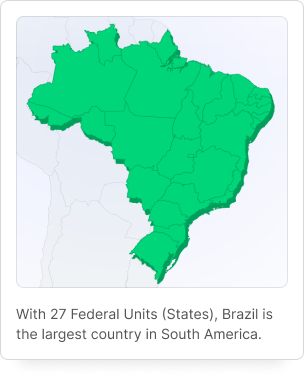Acre
Acre's economy has been steadily expanding, driven by a robust agricultural sector, with a particular emphasis on sustainable farming methods such as agroforestry and organic production. The state's thriving production of rubber, nuts, and coffee , along with its efforts to preserve vast areas of rainforest, showcases its dedication to environmentally responsible practices. In addition to agriculture, the state has made strides in infrastructure development, further facilitating investment opportunities.
- HDI: 0.71 - High
- Population: 830,018 (est)
- Total Area: 164,173 km2
- Roadways: 4,285km
State’s highlights:
- Availability of natural resources;
- Existence of land for farming - converted areas that are underutilized and have low productivity without the need to expand deforestation;
- The state's furniture industry, integrated with certified timber extraction activities, has potential for growth and access to new markets;
- Capacity to densify production chains (densification and processing of primary products, adding value to production chains);
- The Special Zone for Sustainable Development (ZDS) has the potential to expand the integration of the state with its neighbors, by making an export route through the Pacific possible, which would expand the consumer market for the state's products;
- The recent expansion of the state's exports to two neighboring countries, Peru and Bolivia, besides Asia, indicates an alternative for the state's products and its economic growth;
- The state has made progress in the provision of communications infrastructure, standing out on the regional scene in terms of broadband internet access, which could be a differential for the state's development strategy, including investment attraction.
Demographics and Geography
The state of Acre covers an area of approximately 164,173 square kilometers. The capital, Rio Branco, serves as the political, economic, and cultural hub, while other important cities include Cruzeiro do Sul and Sena Madureira. The state of Acre has 22 municipalities into 5 regional development areas. The state is part of Brazil's Northern Border Arc, bordering Peru and Bolivia. Acre's population, which stood at around 830,018 people in 2022, consists of a rich tapestry of ethnicities, including indigenous communities, Afro-Brazilians, and migrants from various regions of Brazil.
A notable demographic trend in Acre is its population growth during the 2011-2021 period, ranking as the third highest in Brazil at 21.5%, compared to the national average of 10.9% and the North region's 17.5%. The state boasts a youthful population with a growth rate surpassing the Brazilian average, along with above-average life expectancy. This youthful demographic is more prominent than the elderly population, resulting in a low aging rate, which is the fourth lowest among Brazilian states. This demographic shift presents an opportunity for increased workforce participation.
Situated in the heart of the Amazon rainforest, Acre's economic landscape is marked by its natural resources, agricultural opportunities, and emerging innovation ecosystem. Located in the Legal Amazon, its natural vegetation is basically composed of open tropical forest and dense tropical forest. The economic potential of the state's flora is immeasurable, both from a timber perspective, the abundance and variety of fruit-producing species for food and industrial use, as well as the existence of medicinal and ornamental plants.
On pressing environmental concern towards deforestation, Acre has an estimated 85% of its territory still covered by native forest, which accounts for 4% of the Brazilian Amazon area.
The state has one of the most advanced institutional and regulatory systems regarding the environment in Brazil (the System of Incentives for Environmental Services - SISA), which allows for the development and support of payment strategies for environmental services and green economy activities, always in harmony with forest preservation.
Conceived as a state strategy for tackling climate change, SISA has completed 13 years since the sanction of State Law No. 2.308/October 2010. The Institute for Climate Change and Regulation of Environmental Services (IMC) is responsible for Sisa's technical coordination. It encompasses 7 programs, from which ISA Carbono stands out.
The Carbon Incentives Program for Environmental Services is considered by environmental experts the most advanced government program for Reducing Emissions from Deforestation and Forest Degradation (REDD) in the world, which makes Acre a benchmark for REDD+ initiatives.
By committing to REDD, Acre is showing that it is doing its part to respond to the requirements of the UN Framework Convention on Climate Change (UNFCCC): to protect the climate system for the benefit of future generations by contributing to reductions in greenhouse gas emissions and increases in forest carbon stocks.
Economy
In recent years, Acre has diversified its economic base. Agriculture has emerged as a key driver, with Acre being a major producer of products like cocoa, coffee, manioc and tropical fruits. Additionally, the state has invested in sustainable practices, particularly in the production of organic and certified products, tapping into the global demand for environmentally friendly goods.
Acre's economic landscape, as of 2021, revealed a GDP (Gross Domestic Product) of R$ 21,37 million, positioning it as the 25th state in Brazil in terms of economic output. According to the Acre State Department of Planning, the state's economy revolves around three main sectors:
· Agriculture is the most important sector of Acre's economy, accounting for 18.9% of the state's GDP in 2021. The primary agricultural products in Acre are soybeans, Brazil nuts, cattle, manioc and corn.
· Industry is the second most important sector of Acre's economy, representing 7.1% of the state's GDP in 2021. The main industrial products in Acre include timber, Brazil nut oil, food products, and construction materials.
· Services are the most significant sector of Acre's economy, making up 74.0% of the state's GDP in 2021. Key services in Acre include commerce, public administration, tourism, and education.
Acre has also seen growth in sectors like tourism and renewable energy. The state's vast rainforests offer ecotourism and ethno-tourism opportunities, attracting nature enthusiasts from around the world. Furthermore, Acre is actively promoting renewable energy projects, harnessing its natural resources to develop sustainable power generation.
The prominent industrial policy of Acre is the Industrial Activity Incentive Policy of the State of Acre. This policy aims to promote the industrial development of the state through tax incentives, financing, and technical support. Tax incentives are granted based on selectivity, progressivity, and temporariness criteria. Acre's industrial policy has been instrumental in the growth of the state's industrial sector. In 2021, the industrial sector accounted for 7.1% of Acre's GDP, generating more than 13,000 direct jobs.
The National Confederation of Industry (CNI) reports that Acre's industries are distributed as follows:
· 46.8% Construction
· 26.5% Public utility industrial services
· 17.6% Food
· 3.6% Wood
· 2.3% Non-metallic minerals
To further its commitment to sustainability, Acre has collaborated with Amazonas and Rondônia to establish the Sustainable Development Zone of the States of Amazonas, Acre, and Rondônia (ZDS Abunã-Madeira). This initiative focuses on promoting environmental sustainability while fostering socio-economic development in the region. ZDS Abunã-Madeira's actions encompass two critical areas: Productive Development (Bioeconomy, Tourism, Agribusiness, Industry) and Economic and Urban Infrastructure (Logistics and Transportation, Energy, Telecommunications). Research and Development (R&D), Information and Communication Technology (ICT), and training initiatives are integral components underpinning these two axes of work.
ZDS Abunã-Madeira encompasses around 32 municipalities across southern Amazonas, eastern Acre, and northwestern Rondônia, covering a total area of 454,220 km² and an estimated population of approximately 1.7 million people as of 2020. This region is crucial, both in terms of environmental challenges and the need for socio-economic development. The overarching goal is to harness the local productive and economic potential, as well as human resources.
Acre has maintained a positive trade balance over the last 11 years, except for 2014. Notably, neighboring countries Peru and Bolivia have emerged as significant recipients of Acre's exports, increasing from 4% in 2000 to 65% between 2019 and 2022. Key products in 2022 include wood (32.1% of the total), soybeans (26.4%)Brazil nuts (17.4%), bovine derivatives (9.5%) and corn (6%).
According to the World Bank's Doing Business Guide for 2021, Acre holds the 14th position among the 27 Brazilian states in terms of business-friendliness. The state's best position was in the "Execution of Contracts" area, in sixth place overall, with 62.9 points. Considering one of the main indicators of Doing Business, the number of hours companies spend on bureaucratic activities, Acre ranks eighth, below the national average.
Infrastructure
The state of Acre boasts two crucial federal highways, BR-364 and BR-317, facilitating transportation and connectivity.
BR-364 stretches across a significant 790 kilometers within Acre, linking 10 out of the state's 22 cities. As it traverses the Acre, Iaco, Purus, Envira, Tarauacá, and Juruá rivers, it serves as the primary lifeline for the southeastern and northeastern regions of the state. This highway not only supports intercity road networks but also fosters integration with Acre's river navigation, connecting to various smaller communities.
BR-317, also referred to as the interoceanic highway, spans 527 kilometers within the state.
This highway commences in Boca do Acre, intersects with the BR-364 near Rio Branco, and follows on to Assis Brasil. Notably, the city of Brasiléia connects to Cobija in Bolivia, while Assis Brasil connects to Iñapari in Peru. Iñapari in Peru is further linked to Lima through Cusco, covering approximately 1,250 kilometers and reaching the Pacific Ocean coast, heading to the port of Chancay, the China’s most ambitious port project in Latin America designed to facilitate trade between the regions.
Furthermore, the ZDS Abunã-Madeira initiative holds the potential to evolve into a logistical hub within the infrastructural network of the Northern Arc, opening to the Pacific Ocean.
Acre's main rivers flow from Peru and Bolivia in a west-east direction, intersecting the state and then proceeding towards the state of Amazonas. Such important rivers include the Juruá, Tarauacá, Envira, Purus and Acre. They receive contributions from an intricate network of small tributaries scattered across the territory, with many of these smaller affluents serving as communication routes for smaller vessels.
Acre's transportation network is complemented by its air connectivity. The state has two cities directly served by commercial flights: Rio Branco and Cruzeiro do Sul. Moreover, ten other locations are equipped with airfields. Among them, Assis Brasil, Santa Rosa do Purus, and Marechal Thaumaturgo maintain airfields coordinated by the army. Manoel Urbano, Feijó, Tarauacá, Porto Walter, Jordão, Xapuri, and Vila Restauração have airfields managed by the state of Acre.
Innovation
Acre is actively cultivating an innovation ecosystem in line with its commitment to sustainable development. Government incentives and partnerships with research institutions have spurred innovation in areas such as biotechnology, sustainable agriculture, and biodiversity conservation. The state's unique ecological assets provide a fertile ground for research and development efforts aimed at preserving and harnessing the richness of the Amazon Forest.
A notable indication of Acre’s dedication to innovation is the recent enactment of Law 4132/2023. The legislation formally establishes the framework for an innovation ecosystem characterized by shared governance with technology-related institutions. It also places a strong emphasis on fostering scientific development, research, technological training, and innovation within the state's production system.
The state has many relevant innovation institutions that contribute to their social and economic growth, like the Technology Park of Acre, the Federal Institute of Acre (Ifac), and the Federal University of Acre (Ufac). These institutions promote technological development and innovation in the state, while also providing infrastructure and services for technology companies, including incubators, accelerators, coworking spaces, laboratories, and event venues.
As a highlight, in 2023, UFAC received R$ 9.8 million for a technical-scientific cooperation project in the laboratory for Applied Research in Computer Vision and Intelligence (Pavic-Lab), the result of a collaboration between UFAC, Motorola, Flextronics and the Foundation for Support and Development of Teaching, Research and University Extension in Acre (FUNDAPE).
The project is the largest investment in technological innovation in Acre, seeking to train human resources with the ability to apply and develop the most modern computer vision and intelligence software techniques and tools, through scientific research and technology training in the design area.
About Brazil
Brazil is the world's fifth-largest country and the seventh most populous, holding a distinguished position as the largest economy in Latin America and the Southern Hemisphere. As one of the world's biggest agricultural producers, Brazil plays a significant role as an agri-environmental strength, preserving more than 60% of its territory while reaching record production. Solid institutions, a democratic regime, and monetary stability support Brazil's economic landscape, making it a reference of stability and growth in the region.

Regions

North Region
With seven states, the region is dominated by the Amazon Rainforest, the largest tropical rainforest in the world. The economy is influenced by agriculture, forestry and mining, with the sustainable management of natural resources at the center of public policies.

Northeast Region
The region presents a lengthy coastline along its nine states. Although agriculture has been a traditional economic driver, renewable energy, petrochemicals and innovation have seen a significant growth in recent years, changing the region's vocation.

Central-West Region
Only three states and a Federal District make it the agricultural heartland of Brazil. It is also home to a diverse array of wildlife and ecosystems, including parts of the Amazon rainforest and the Pantanal, the world's largest tropical wetland area. Brasília, the country's capital, is an important hub in the region.

Southeast Region
Marked by its dynamic urban centers, the region drives Brazil's innovation, commerce and industrialization. Comprising four states, it is home to the country's financial capital, São Paulo, which is also Latin America's economic center and one of the major global cities.

South Region
The region stands out as a well-developed portion of Brazil. It has a strong economic performance supported by a highly productive agriculture and a skilled industry, which reflects in the region's high standard of living, efficient infrastructure and economic stability.

